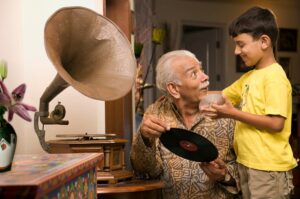People are generally reluctant to broach the subject of suicide directly. Insecure and pubescent young people find it even more difficult. This is because suicide exerts a certain fascination on the one hand, but is also a deterrent on the other.
Death is a distressing and yet omnipresent topic. This is precisely why it is so important to talk openly about the subject with children. This becomes especially difficult when it comes to suicide. Although thousands of people choose suicide every year in Germany alone, adults have their problems dealing with this topic.
This makes it all the more difficult to talk about suicide in the family. This guidebook is intended to provide insight into different ways of dealing with this as a family.
Table of contents
Talk About It Objectively
This is the advice of Jesper Juul, a parenting expert and family therapist. Asked about the right way to deal with the subject of suicide, he says the following: One should always deal honestly with the child. Before it has reached an age of about ten years, however, concise information is sufficient. When asked why a family member is no longer there, one should explain that he or she has died. That’s all children under the age of ten need to know.
Grief Is Difficult
In any case, children often find grieving difficult. Usually, after a suicide, one cannot enter the room where the loved one died for a while. The body itself is released for autopsy. Sometimes a suicide note is found, often there is simply no trace of the family member. The child, in the case of suicide, usually did not have the opportunity to say goodbye to his family member. If someone dies after a long illness, closure is comparatively easier.
Additionally, children can be traumatized if they have been informed about the suicide. They are then shocked and cannot grasp what has happened. The world seems unreal to them, everything seems muted. This time is very difficult because sometimes you are not even able to feel anything.
Only when pain and grief follow, a wave of emotions breaks over relatives. This is very unpleasant at first, but later has a liberating effect.
Childlike Mourning
Children grieve differently than adults. This is partly because – depending on their age – they have not yet developed abstract thinking. In addition, children’s grief is always characterized by fleeting moments. Thus, after a death, children find themselves in a constant state of alternating sadness and cheerfulness. As children develop into adolescents and enter adulthood, their view of past deaths changes.
Because they perceive death differently, children process the loss of deceased very differently. They make themselves a bit more aware of what has happened in childlike play. This is only possible if it is not suppressed by adults.
Grief after the suicide of a loved one: a constant challenge.
Grief after a suicide is very different from that after a “natural” death. Children who have lost a loved one due to a suicide struggle with the following factors.
-
The death was sudden and unexpected.
-
The deceased is devalued by some relatives.
-
The death often occurred violently.
-
The child may have found the suicidal person dead themselves.
-
Older kids and teens suffer from feelings of guilt. They think they could have prevented the suicide.
-
Aggravation of grief by official procedures (e.g., apartment search and interrogation).
-
Injury to their own self-esteem because a loved one was so “weak” to take their own life.
What is particularly difficult is that suicide is taboo. Thus, children often get no or insufficient answers to their questions. After a certain age, however, it is important for them to understand exactly what happened.
If the children know that a suicide has occurred, they are often alone – outside the family – with their problem. Friends and acquaintances react with silence to the confrontation with the subject of suicide. Hardly any young people are in a position to help further.
Suicide – What Now?
Children and adolescents absolutely need support when they come into contact with the subject of suicide. If they are alone with their grief, the following consequences threaten:
-
Isolation.
-
Development of their own suicidal thoughts.
-
Suffering due to shame
-
Dwindling self-esteem.
-
Depressive moods.
-
Burdening feelings of guilt.
Younger children must first be gently taught that the family member will not come back – even though he or she was neither old nor ill, nor had an accident.
School children want and should know how the family member died. Starting around age ten, the question “Did he or she do it on purpose?” becomes interesting.
Teenagers, on the other hand, usually understand the difference between suicide and natural death fairly quickly. However, they agonize over the question “Why did he or she do it?” and want to understand how this misfortune could have occurred.
Unfortunately, these questions are often discussed much too late. This is quite understandable, as this conversation represents a difficult step for the child’s grieving parents. They are heavily burdened by the death itself and often do not have the strength to talk about it in a matter-of-fact way.
The resulting silence puts a strain on the family. The adults are then constantly afraid that the children might eventually learn the truth. The suicide in the family circle thus becomes a secret.
According to the self-help group AGUS e.V., parents should, among other things, meet the following requirements before talking to the child about the death.
-
Use age-appropriate images and terms.
-
Think about the choice of words in advance.
-
Paraphrase frightening details only briefly or explain them matter-of-factly.
-
Emphasize that the child is not to blame. Also let the child know that he or she was loved by the deceased family member.
What If There Is A Suicide Note?
The question arises as to whether a suicide note can help cope with the loss of a loved one. In fact, many loved ones wish they could find a letter. It can explain why things happened in the first place. To be sure, the contents of such a letter are usually very saddening. It still helps to know the last feelings and motivations of the deceased.
The suicide note is not always such a disclosure. Sometimes suicidal people say goodbye with accusations against the surviving relatives, blaming them for everything. In such cases, the suicide note becomes an additional burden.
Provided the suicide note is written in a way that clarifies the “why?” and is not teeming with accusations, it can certainly ease the grief of young people. Especially for older kids, it is very important to understand the motives of the deceased. Only in this way can the loss be processed well.
What Can Young People Do When A Relative Threatens Suicide?
Keeping quiet about such situations or deliberately ignoring them does not make things better in the long run. If a young person feels overwhelmed by this, he or she should definitely seek the advice of an adult. Because kids and teenagers often can’t cope when they come into contact with the subject of suicide.
However, older kids and teens who feel capable of doing so should definitely talk to the person in question about it. Expressions such as “I care about you”. or “I’m worried about you”. can save lives in some circumstances. If the suicidal person finally opens up, a doctor can be contacted – with or without the help of an adult – to get professional help (psychotherapy, medication and self-help groups) as quickly as possible.









